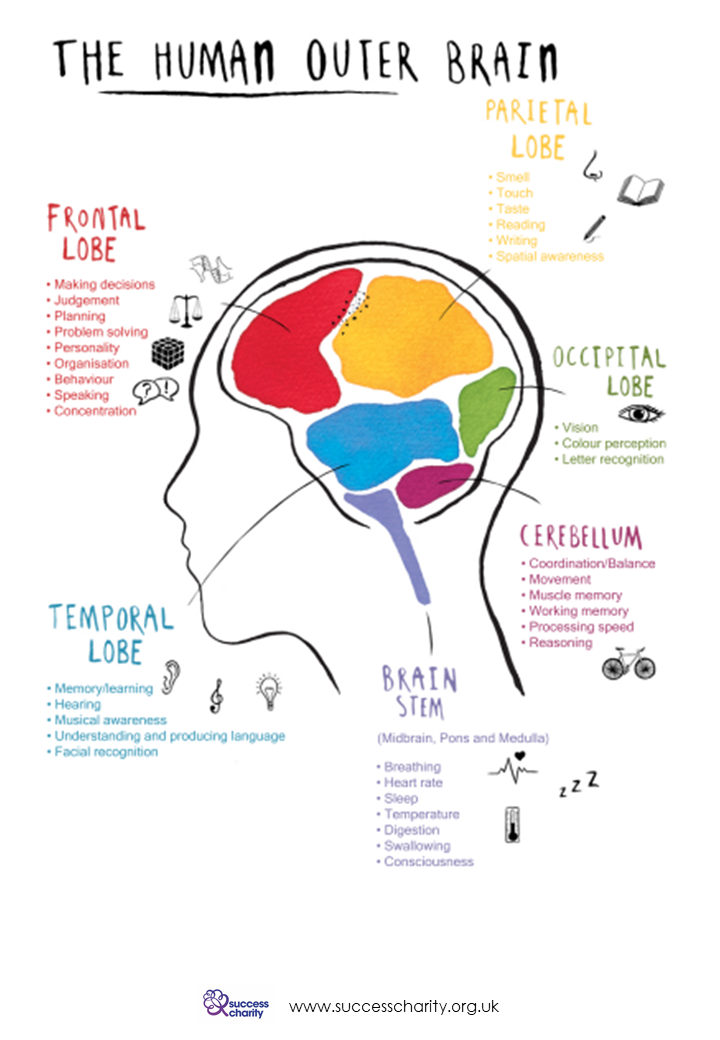About the Brain
The Location of Brain Tumours
Tumours are named according to their location within the brain, individual features that can be seen on a scan and where it has been possible to undertake a biopsy and what it looks like under a microscope.
Types of Brain Tumours
Brain tumours in children are rare, but of those that are diagnosed ; the most common type of brain tumour in children is a low grade Astrocytoma, which account for 30% of all brain tumours in children.
The Outer Brain
The outer brain, which is also known as the cerebral cortex can be divided into four sections, which are known as ‘lobes’.
Each lobe is associated with different functions that make us unique individuals. Our ability to think, to reason and imagine all originate from these different lobes in the outer brain. The four lobes are the frontal lobe, parietal lobe, occipital lobe, and temporal lobe.
Frontal Lobe
The frontal lobe, coloured red in our picture, is responsible for supporting our decision making and judgement, It gives us the ability to plan and organise and is responsible for our behaviour, personality and speech.
The motor cortex, located at the back of this lobe receives information from various lobes of the brain and utilizes this information to carry out all of our body movements.
Parietal Lobe
The parietal lobe, coloured yellow in our picture, is associated with processing smell, touch and taste. It is also the lobe that helps us read and write.
Temporal Lobe
The temporal lobe, coloured blue in our picture, houses our auditory cortex and hippocampus. The auditory cortex is important for interpreting sounds and the language we hear.
The hippocampus is associated with the formation of memories.
Occipital Lobe
The occipital lobe, coloured green in our picture, houses our primary visual cortex, which receives and interprets information from the retinas of the eyes and supports colour recognition.
The Brain Stem
The brain stem, coloured light blue in our picture, comprise the midbrain, pons, and medulla. Although small, it is an extremely important part of the brain, responsible for the regulation of cardiac and respiratory processes as well as consciousness. Like the thalamus it acts as a junction box that allows nerve connections from the motor and sensory systems of the cortex to pass through it to communicate with the peripheral nervous system via the spinal cord.


Human Diencephalan
Many will have heard Dr Helen Spoudeas, (our founder), refer to this as ‘the dinosaur brain’, it is located deep in the middle of the brain underneath the cerebrum and above the pituitary gland.
The diencephalon is a part of the brain that includes the thalamus and the hypothalamus and forms the link between the nervous system and the endocrine system. It functions by receiving signals from our nerve network (the nervous system) though a junction box (Thalamus), the hypothalamus then interprets those signals and asks the pituitary gland (which largely controls the endocrine system) to respond by excreting hormones. These hormones keep the body’s functions in balance; supporting blood pressure, heart rate, hunger, the sleep-wake cycle, memory, salt and water balance, body temperature and growth.
Surgery, traumatic brain injury, tumours, and radiation most commonly contribute to imbalance that cause either full or partial disregulation within the diencephalan.
Two Hemispheres
The brain contains two hemispheres that each perform a number of functions, communicating with the other via a central band of nerve fibres.
The left hemisphere controls the right side of the body, the right hemisphere the left side of the body. It is said that an individual will use one side of the brain more than another, referred to as a dominant side. Your dominant side can be identified by the hand you write with, a type of thinking or personality trait.
A brain injury received to the right hemisphere will likely affect functions on the right of the body and vice versa.


The Endocrine System.
The endocrine system is a network of glands in your body that produce hormones (chemical messages) that help cells talk to each other, using the blood stream to travel to different areas of the body.
Many glands make up the endocrine system and each has a different function.
- The Hypothalamus tells your pituitary gland to start or stop making hormones.
- The Pituitary gland uses information it gets from your brain to tell other glands in your body what to do.
- The Pineal gland makes a chemical that helps your body get ready to go to sleep.
- The Thyroid gland controls your metabolism. If the gland doesn’t make enough thyroid hormone everything happens more slowly. If it makes too much, everything speeds up.
- The Parathyroid gland is a set of four smaller glands behind your thyroid gland that support bone health.
- The Adrenal glands produce hormones that you can’t live without, too much or too little can affect metabolism, blood pressure, the immune system, sex hormones and the body’s response to stress.
- The Pancreas is responsible for producing the hormones that ensure you have the right amount of sugar in your bloodstream and your cells. Too much or too little can have a significant impact on your health.
- The Ovaries make female hormones which support the development of breasts in puberty, regulate the menstrual cycle, and support a pregnancy.
- The Testes male hormone which support facial and body hair at puberty.
If your endocrine system isn’t healthy, you might have problems developing during puberty, getting pregnant, or managing stress. You also might gain weight easily, have weak bones, or lack energy because too much sugar stays in your blood instead of moving into your cells where it’s needed for energy.
